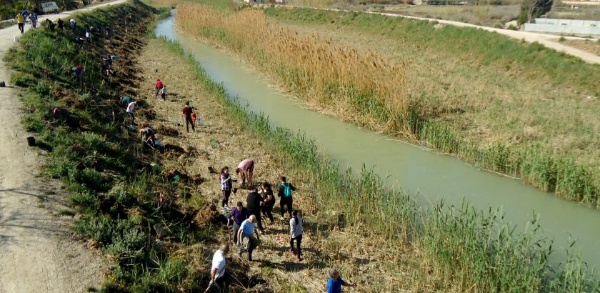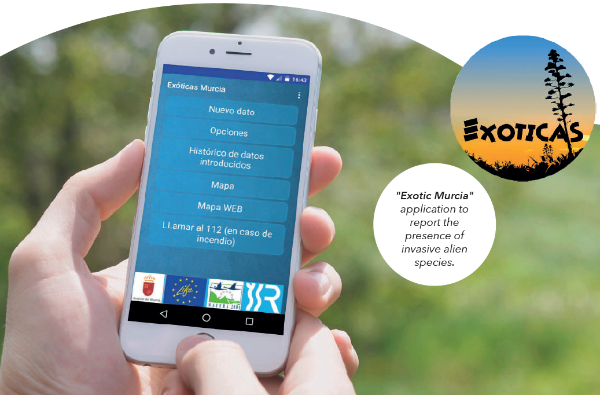This LIFE project has been developed in the Region of Murcia, in stretches of the Segura River located in the municipalities of Moratalla, Calasparra and Cieza. The action area includes the natural areas of Cañaverosa and Almadenes, and about 80% of the project area is located in areas of the Natura 2000 Network, with Community Interest Habitats (92A0, 92D0 and 7210).
By the end of the project, we can state that the overall results of the project have been satisfactory and most of the work has been carried out in accordance with the planned schedule.
Coordination and general administration began with the appointment of the personnel assigned to the project and its partners (35 Members) and later with the celebration of the Kick-Off meeting.
The final state of the main conservation actions is summarized below:
- All the objectives regarding land stewardship in Action C1 has been achieved since 4 land stewardship agreements affecting public domain and 15 affecting private land have been singed. These agreements involve a total of 986 ha subject of land stewardship where project results can be sustained along time (781 ha from public agreements, 96 ha from private agreements and 109 ha from oral private agreements).
- In Action C2, public domain demarcation along 19.5 km of the Segura River has been executed in 2019 (initial target 10 km).
- In relation to action C3, Early Warning Network through new Information and Communication Technologies, CARM put into operation a server, a web and a mobile application for Android, operational since October 2017 and functioning to date. https://exoticasinvasoras.carm.es/
- Regarding actions of ecological engineering, CARM has carried out in C5 cuttings and clearings of exotic tree species in 1.45 ha of 9 locations (3 in El Menjú, in Cieza, and the others in different locations of Cieza and Calasparra). Works started in January 2016 and since the initial cuts two controls of shoots and shoots, plantings of cuttings and watering have been carried out. Last works to revitalize plantations were done between February and July 2019.
- CHS began action C4 in January 2016, with the initial clearing of invasive species (Arundo donax and Nicotiana glauca mainly). The total area of action sums up to 10.36 ha (52 plots). In 4.89 ha of this total surface area (18 plots), intensive maintenance tasks are carried out (frequent cutting), having carried out about 12 re-runs per tile (1 more than expected) which is equivalent to an effective area of 58.36 has. In the remaining 5.46 ha (22 plots) a gentle maintenance has been carried out (spaced and longer cuttings), with finally 10 re-runs equivalent to an effective surface of 47.27 ha. The objective was to see what type of treatment is most effective in the fight against IAS, being results quite similar. The sum of effective area between extensive and intensive maintenance supposes a total of 105.63 ha.
- Action C6, started between January and February 2016, after the clearing of action C4, with the planting of associated native vegetation. Since then, CHS has carried out maintenance tasks (scheduled irrigations) between May and August 2016, 2017 and 2018. In the last quarter of 2016 and first quarter of 2017, replacement of specimens that had not survived was made. At the beginning of 2016, 2,385 specimens of arboreal species and 8,537 specimens of shrub species were planted in 11.92 hectares distributed over the 52 plots of the project. In the replacement of trees, 2,953 specimens of shrub species and 1,709 of arboreal species were planted. In total, 15,567 specimens of native plants have been planted in the area of action with the aim of generating competition with the IAS and, in this way, slow down its expansion.
- The monitoring actions D1 and D3 have been carried out by UMU, with annual monitoring reports of the Riparian Autochthonous Habitats (HRAs) and their associated biodiversity in the Ecological Monitoring Stations (EMEs), and the evaluation of the socioeconomic impact and ecosystem services. After the tasks of initial evaluation, establishment of reference conditions and ecological monitoring indicators, which were carried out in the framework of the preliminary actions (Action A1), in 2015, during 2016, 2017 and 2018, UMU has carried out the EMEs) The EMEs are 16 plots out of the 52 where the project operates and that have been selected to study the evolution of different ecological indicators of vegetation, fauna, water quality and riverbank quality. Final monitoring results allow us to affirm that the riparian vegetation, the aquatic macroinvertebrates, the birds and the otter are favored by the actions of the project, and that the physical-chemical quality of the water is maintained at levels of very good quality.
- Regarding project communication, the website ripisilvanatura.eu is kept operational and updated by CHS and has around 500 monthly visits and a total of 29,161 accesses from June 2015 to September 2019. There are also active profiles in social networks Facebook (565 likes) and Twitter (491 followers) (Action E1). CARM is in charge of the development of the Awareness and Dissemination Plan in School Centers of Cieza and Calasparra, which has been operating since 2017 and has registered more than 6,000 participants. Within the framework of this program, a video and a didactic unit have been produced. The campaign "buy your pet with responsibility" by ANSE has involved the distribution of more than 400 posters to 126 centers related to pets and plants (shops, nurseries and florist, etc.) in 27 locations across the region. In relation to awareness raising of the local population, the City Councils of Cieza and Calasparra, have produced during 2018 the communication material foreseen in the project. On the other hand, 59 volunteer sessions have been organized and have supported various tasks of the project. They have reached 768 participants.
- The International Seminar on Riparian Exotic Invasive Species was held in Cieza on March 14 and 15, 2018 and had 55 participants. The International Seminar on Habitat 920A, was held in June 2019 within the celebration of the Iberian Congress of River Restoration in the Region of Murcia (300 attendants).

